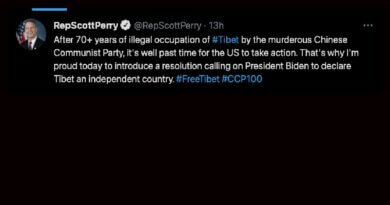The Sweet Requiem and Reflections
Tenzin Gesar | Gesar Times | Nov 9 2018

A narrative feature film, The Sweet Requiem, is the latest ode to Tibet and the Dalai Lama by producers and directors Ritu Sarin and Tenzing Sonam of www.whitecranefilms.com
Their strong body of work includesfourteen films, eight installations, fivevisual archives, DIFF (DharamsalaInternational Film Festival) etc, spanning more than 33 years. Their most recent previous films are Dreaming Lhasa (2009), The Sun Behind the Clouds (2009), and When Hari Got Married (2012), all of which were very well received and screened globally. The Sweet Requiem had its world premiere recently at Toronto International Film Festival (TIFF 2018). Its US premiere was at Mill Valley International Film Festival 2018. Its Asian premiere was at the Dharamsala International Film Festival (DIFF) 2018. The next 2018 screening is at the Hawaii International Film Festival.From these, it will move on and be circulated and screened at many such events and festivals.
The Sweet Requiem is the story of Dolkar(Tenzin Dolkar), a Tibetan refugee in Indiawho works in a beauty salon. Like any 26 year old, she lives a happy and somewhatcarefree life: birthday parties, nights out with friends, dance classes, and an interest in Bollywood songs and dances. Dolkar has a break-up and her friend Dorjee (Shavo Dorjee) is trying his luck in gaining her love. Dorjee is a political activist at Majnu Ka Tilla (Tibetan Colony), Delhi. Dolkar’s comparatively joyous lifeplummets when during a candlelight vigil she sees the man who guided her and others during their perilous trek from Tibet. Gompo (Jampa Kalsang) was one of the guides on the snow-mountains who helped Tibetan refugees to freedom.
Years before, when Gompo was returning to Lhasa, he met Dolkar and a group lost in the mountains. Dolkar’s father, Migmar(Rabyoung Thonden Gyalkhang) requested that Gompo help them to cross over to Nepal, or at least stayed with them till the nearest pass.
Dolkar is still tormented by her memories of that perilous journey across those snowy mountains. Seeing Gompo again in Majnu Ka Tilla, Dolkar relapses into the trauma of her past years of escape, when she left her nomad home in Tibet, her mother and her little sister, who all still live on the vast plateau.
It had been a majestic starry night, when Dolkar’s mother had decided to send her to India to get a better education, to receive blessings from the Dalai Lama, and to be near Him.
Now, on a roof top in India, when Dolkarobserves her Indian neighbors, especially the interactions between the mother and a daughter, she deeply misses her mother and sister back in Tibet.
In India, Gompo is known as Gyatso. Gyatso is getting quite a name for himself as an underground political activist from Tibet. Dorjee helps Gyatso. Dorjee keeps tracks of political happenings in Tibet,including all the self-immolations. Gyatsoshares his stories of the Tibetan struggle inside Tibet to refugees in Delhi, andspecifically about the self-immolations, to show them that all is not yet lost. Meanwhile Dolkar also watches aboutself-immolations via mobile, yet she is doubtful about Gyatso’s stories and his activities in India because of her experience with the guide when she was a kid. Dolkar started surreptitiously following his movements in India.
These scenes are mostly set in the old camp part of Manju Ka Tilla. Gyatso finds he too is trapped by two Chinese spies. Both spies are Tibetans who came from Tibet. These spies would throw stashes of money on the table and would try to buy information from people, even in India. The spies walked around as if they were in Tibet or China, with no fear, and no remorse, but they were dressed well – and confident. They compiled records of all Tibetans from Tibet or in Tibet. It is just a phone call away to China and Tibet for them, while Gyatso’s or Dolker’s calls to their homes in Tibet rarely ever get connected.
Unlike Ritu and Tenzing’s first feature film, Dreaming Lhasa, The Sweet Requiem has full-fledged dialogue in Tibetan language. In Dreaming Lhasa, the main character is a Tibetan born in the US. She comes to claim her roots in Dharamsala, the exile capital. The Sweet Requiem is more convenient for Tibetans of all agesto understand the subtleties, which ultimately seems to be the filmmakers’ primary task. It has sub-titles in English.
To quote an eight-year-old child in the audience, she said, ‘It is too short’, even though it was 91 minutes long. The childwas brought to see the film like all the other children, as for better or worse, it is her story too. Just as she now understands all the Bollywood films and cartoon shows, we hope she understands such films about her own people and story too.
Current headlines are about refugees and immigration, Syrians, Yazidas, Rohingyaor Africans. This film is about Tibetan refugees, and how their people still try to escape at gunpoint: in 2006, on the 30thSeptember, a group of Tibetans werefleeing over Nangpa La or Mt Cho Oyo, the base of Mt Everest.The Chinese border guards shot and killed aseventeen-year old nun from the group. This tragedy, captured by Romanian climbing expedition and revealed globally in the film Murder in the Snow, inspiredThe Sweet Requiem.
Once any Tibetans safely reach India, there follows the pain of being a refugee.Their homes, parents, relatives are all in Tibet, while in India they wait for freedom. Both through oppression and the forces of nature people die and many are not fatedto see their families again.
Dolkar’s character is one such example. She is propelled into her memories by Gompo (Gyatso’s) sudden appearance in Majnu Ka Tilla, Delhi.
Despite being Tenzin Dolker’s first film, she pulls well and gives a strong immersion into the character in such a subtle role.
Seasoned actor Jampa Kalsang, as a young guide and mature underground Free Tibet activist who seeks asylum in India, gives the best performance in the film. Jampa Kalsang has an astonishingscreen presence. Shavo Dorjee gives another excellent performance, as doesRabyoung Thonden Gyalkhang. These are the actors playing the four main characters.
Pristine Tibet (Ladakh) and Delhi haze, art and activism, documentary and fiction,gunshots, self-immolations, candlelightmarches, Martyrs’ Day, the Dalai Lama, the nice score when Dolkar is on her watch for Gompo or Gyatso, all culminateinto a fine humane and universal scream for love, peace, freedom and justice.
The ominous Chinese spies are played by two Lhakpa Tserings. They should be congratulated for having the guts to playsuch roles. These characters beg questions for all who want to challenge Chinese might. The current global trends like Confucius Institutes or loan traps, the money stashes surreptitiously being distributed as bribes, the raising of Chinese flags in exile… whatever may be the gentle motivations, the theme will haunt us all.
Now our task is to watch what pressure tactics the Chinese regime will inevitably employ to try and remove this truthful film from the open market, from film festivals, or from the global public conscience. In what ways can we help to give this film a global reach to global audiences, and address any resultant media war head on? Before watching this melancholy tale from Tibet, you must prepare yourself with enough tissues to brave it. It is like watching South Korea’s Classic, Bollywood oldies like Ankiyon KeJharokhon Se or Kya Kehna, China’s To Live or Pakistan’s BOL, in emotional content.
This film will leave you gasping for more, and feeling just as the kid said, ‘It is too short’.
Tenzin Gesar writes at https://gesartimes.wordpress.com/




